The Effect of Powder Temperature on Semi-Solid Powder Rolling AA2024 Based on Experiments and Numerical Simulation
Abstract
:1. Introduction
2. Experiments
3. Theoretical Background
4. Results and Discussion
4.1. The Effect of Powder Temperature on the Strip Microstructure
4.2. Simulation and Analysis of the Strip Temperature Field
4.2.1. Establishment of the Model
4.2.2. Analysis and Verification of the Strip Temperature Field
4.3. The Effect of Powder Temperature on the Strip Temperature
4.4. The Effect of Powder Temperature on the Relative Density and Rolling Force
5. Conclusions
- (1)
- The grain of strips after SSPR is refined with the increase in the semi-solid powder temperature, and finer microstructures with fewer pores are obtained at 600 °C due to a higher liquid fraction and more broken powders, while the grain coarsening and cracks appear at 610 °C due to much liquid flowing. On the basis of microstructure analysis, it is deduced that powder crushing, liquid solidification, densification and grain coarsening exist simultaneously during SSPR.
- (2)
- As the simulated temperature of strips is mainly consistent with the experimental value in sections I, II and III, it is confirmed that the model based on the Fourier equations and its parameter setting are correct, which considers heat exchange of solidification, deformation, friction, convection, radiation and conduction. As the strip temperature in the main deformation sections (II and III) is between 580 and 509 °C (in a porous solid state), the SSPR at 600 °C can be considered as a porous hot rolling, integrating powder crushing, deformation, densification and solidification.
- (3)
- According to the analysis of microstructures and simulated strip temperatures during SSPR, it is concluded that the SSPR at powder temperatures of 580, 590 and 600 °C is actually a porous hot rolling, as it has similar finer microstructures and is mainly in a porous solid state in sections II and III (the rolling force plays a major role in deformation). The SSPR at powder temperatures of 520, 540 and 560 °C can be regarded as a powder hot rolling, because it has similar larger particles and is basically in a solid state in sections II and III.
- (4)
- Under the combined actions of powder crushing, grain coarsening and liquid flowing, the measured and calculated relative densities increase with increasing powder temperature and reach a maximum at 600 °C, and then the measured relative density decreases at 610 °C, which confirms that it is unable to obtain a full density during SSPR. The measured and calculated rolling forces decrease with increasing powder temperature, because the liquid fraction increases and the deformation resistance decreases. Therefore, combined with the results of the microstructure analysis, the optimal powder temperature for SSPR is 600 °C. The simulated rolling force and relative density are very low in section I, increase slowly in section II and then rapidly increase to the maximum in section III, finally keeping constant in section IV. The effect of powder temperature on the simulated rolling force and relative density of the strips is basically in good agreement with the experimental results, which further confirms that the established SSPR model is reasonable.
Author Contributions
Funding
Data Availability Statement
Conflicts of Interest
References
- Huang, M.; Jiang, J.; Wang, Y.; Liu, Y.; Zhang, Y.; Dong, J. Thixotropic deformation behavior, rapid spheroidization and solid-liquid homogenization of semi-solid Al0. 8Co0. 5Cr1. 5CuFeNi HEA with multilevel microstructure. Scr. Mater. 2023, 229, 115384. [Google Scholar] [CrossRef]
- Aghajani, S.; Pouyafar, V.; Meshkabadi, R.; Volinsky, A.A.; Bolouri, A. Mechanical characterization of high volume fraction Al7075-Al2O3 composite fabricated by semisolid powder processing. Int. J. Adv. Manuf. Technol. 2023, 125, 2569–2580. [Google Scholar] [CrossRef]
- Wang, Y.; Zhang, X.; Chen, T. Heterogeneous lamella structure design to simultaneously strengthen and toughen aluminum alloys. J. Alloys Compd. 2023, 930, 167456. [Google Scholar] [CrossRef]
- Ye, Y.; Xia, H.; Lin, Y.; Chen, F.; Shen, Q. Refined WC grain size and improved mechanical properties in a hardmetal WC-8Co processed via short-time semi-solid hot pressing. J. Alloys Compd. 2021, 889, 161560. [Google Scholar] [CrossRef]
- Zhang, X.; Wang, Y.; Chen, T.; Xu, H.; Ma, J. Achieving a heterogeneous lamella-structured aluminum alloy with excellent synergy of strength and ductility by powder thixoforming. Mater. Sci. Eng. A 2022, 838, 142781. [Google Scholar] [CrossRef]
- Son, Y.G.; Jung, S.S.; Park, Y.H.; Lee, Y.C. Effect of Semi-Solid Processing on the Microstructure and Mechanical Properties of Aluminum Alloy Chips with Eutectic Mg2Si Intermetallics. Metals 2021, 11, 1414. [Google Scholar] [CrossRef]
- Chen, L.; Qi, Y.; Fei, Y.; Du, Z. Enhanced Mechanical Properties and Thermal Conductivity for GNPs/Al2024 Composites with In Situ SiC Nanorods. Met. Mater. Int. 2021, 27, 4263–4270. [Google Scholar] [CrossRef]
- Li, P.; Chen, L.; Cao, B.; Shi, K. Hierarchical microstructure architecture: A roadmap towards strengthening and toughening reduced graphene oxide/2024Al matrix composites synthesized by flake powder thixoforming. J. Alloys Compd. 2020, 823, 153815. [Google Scholar] [CrossRef]
- Wu, M.; Wang, B.; Luo, X.; Liu, M.; Wang, Y.; Yu, J.; Li, Y. Deformation behavior and forming process simulation of semi-solid powder rolling based on the combined constitutive model. Mater. Res. Express 2022, 9, 126510. [Google Scholar] [CrossRef]
- Wu, M.; Liu, J.; Luo, X.; Liu, Y.; Liu, M.; Kong, C.; Wang, Y. Numerical Simulation and Parameter Optimization for Semi-solid Powder Rolling of Al–Cu–Mg Alloy. Trans. Indian Inst. Met. 2023, 76, 1771–1780. [Google Scholar] [CrossRef]
- Wojtaszek, M.; Korpała, G.; Śleboda, T.; Zyguła, K.; Prahl, U. Hot Processing of Powder Metallurgy and Wrought Ti-6Al-4V Alloy with Large Total Deformation: Physical Modeling and Verification by Rolling. Met. Mater. Trans. A 2020, 51, 5790–5805. [Google Scholar] [CrossRef]
- Kapranos, P. Current State of Semi-Solid Net-Shape Die Casting. Metals 2019, 9, 1301. [Google Scholar] [CrossRef]
- Fang, J.X.; Wang, J.X.; Wang, Y.J.; He, H.T.; Zhang, D.B.; Cao, Y. Microstructure evolution and deformation behavior during stretching of a compositionally inhomogeneous TWIP-TRIP cantor-like alloy by laser powder deposition. Mater. Sci. Eng. A 2022, 847, 143319. [Google Scholar] [CrossRef]
- Zhu, Z.Y.; Liu, Y.L.; Gou, G.Q.; Gao, W.; Chen, J. Effect of heat input on interfacial characterization of the butter joint of hot-rolling CP-Ti/Q235 bimetallic sheets by Laser+ CMT. Nat. Publ. Group 2021, 11, 10020. [Google Scholar] [CrossRef]
- Peng, S.; Wang, J.; Wang, M.; Dong, X.; He, X.; Yu, L.; Zhang, X. Investigation on the compression properties of semi-solid Be-Al alloy. Mater. Lett. 2022, 321, 132431. [Google Scholar] [CrossRef]
- Chen, G.; Lin, F.; Yao, S.; Han, F.; Wei, B.; Zhang, Y. Constitutive behavior of aluminum alloy in a wide temperature range from warm to semi-solid regions. J. Alloys Compd. 2016, 674, 26–36. [Google Scholar] [CrossRef]
- Mei, D.; Wang, H.; Yao, Z.; Li, Y. Numerical modeling and optimization of the segmented PbTe–BiTe-based thermoelectric leg. J. Appl. Phys. 2016, 120, 124503. [Google Scholar] [CrossRef]
- Nithin, A.M.; Davidson, M.J.; Rao, C.S.P. Microstructure modeling of a sintered Al–4Si–0.6 Mg alloy extruded at semi-solid temperature ranges. Proc. Inst. Mech. Eng. Part E J. Process Mech. Eng. 2022, 236, 394–403. [Google Scholar]
- Luo, X.; Li, M.; Ren, J.; Zhao, Y.; Wu, M.; Huang, B. Deformation Micromechanism and Constitutive Analysis behind the Semisolid Powder Compression of Medical Mg-Zn Alloy. JOM 2022, 74, 899–908. [Google Scholar] [CrossRef]
- Hu, Z.; Li, J.; Tan, Y.; Jiang, D.; Li, P. Interaction of impurity distribution and groove at the micro-zone of solid/liquid interface in silicon. Mater. Des. 2022, 214, 110384. [Google Scholar] [CrossRef]
- Li, F.; Chen, P.; Han, J.; Deng, L.; Yi, J.; Liu, Y.; Eckert, J. Metal flow behavior of P/M connecting rod preform in flashless forging based on isothermal compression and numerical simulation. J. Mater. Res. Technol. 2019, 9, 1200–1209. [Google Scholar] [CrossRef]
- Wang, Y.; Zhao, S.; Guo, Y. Numerical Simulation and Experimental Investigation of the Preparation of Aluminium Alloy 2A50 Semi-Solid Billet by Electromagnetic Stirring. Materials 2020, 13, 5470. [Google Scholar] [CrossRef]
- Zhang, Y.; Liu, J.; Fu, Y.; Jie, J.; Lu, Y.; Guo, Q.; Wang, T.; Li, T. Microstructure and Fabrication of Cu-Pb-Sn/Q235 Laminated Composite by Semi-Solid Rolling. Metals 2018, 8, 722. [Google Scholar] [CrossRef]
- Li, F.; Liu, Y.; Yi, J. Modeling the Thermal Fields of Deposited Materials during the Spray Rolling Process. Metall. Mater. Trans. A Phys. Metall. Mater. Sci. 2014, 45, 4012–4021. [Google Scholar] [CrossRef]
- Wang, D.; Zhou, C.; Xu, G.; Huaiyuan, A. Heat transfer behavior of top side-pouring twin-roll casting. J. Mater. Process. Technol. 2014, 214, 1275–1284. [Google Scholar] [CrossRef]
- Li, F.; Yi, J.; Eckert, J. Deformation Behavior of Powder Metallurgy Connecting Rod Preform During Hot Forging Based on Hot Compression and Finite Element Method Simulation. Metall. Mater. Trans. A 2017, 48, 2971–2978. [Google Scholar] [CrossRef]
- Wu, Y.; Kim, G.Y. Compaction behavior of Al6061 powder in the semi-solid state. Powder Technol. 2011, 214, 252–258. [Google Scholar] [CrossRef]
- Wu, M.; Liu, J.; Luo, X.; Liu, Y.; Cai, R.; Kong, C.; Wu, Q. The Powder Breakage Behavior and Mechanism during Semi-Solid Powder Forming. JOM 2023, 75, 2511–2524. [Google Scholar] [CrossRef]
- Aghajani, S.; Pouyafar, V.; Meshkabadi, R. Wear behavior of high volume Al2O3-reinforced Al7075 matrix composites fabricated by semi-solid powder processing. Proc. Inst. Mech. Eng. Part E J. Process Mech. Eng. 2022, 236, 2689–2700. [Google Scholar] [CrossRef]
- Wu, Y.; Kim, G.-Y.; Anderson, I.E.; Lograsso, T.A. Experimental study on viscosity and phase segregation of Al-Si powders in microsemisolid powder forming. J. Manuf. Sci. Eng. 2010, 132, 3–7. [Google Scholar] [CrossRef]



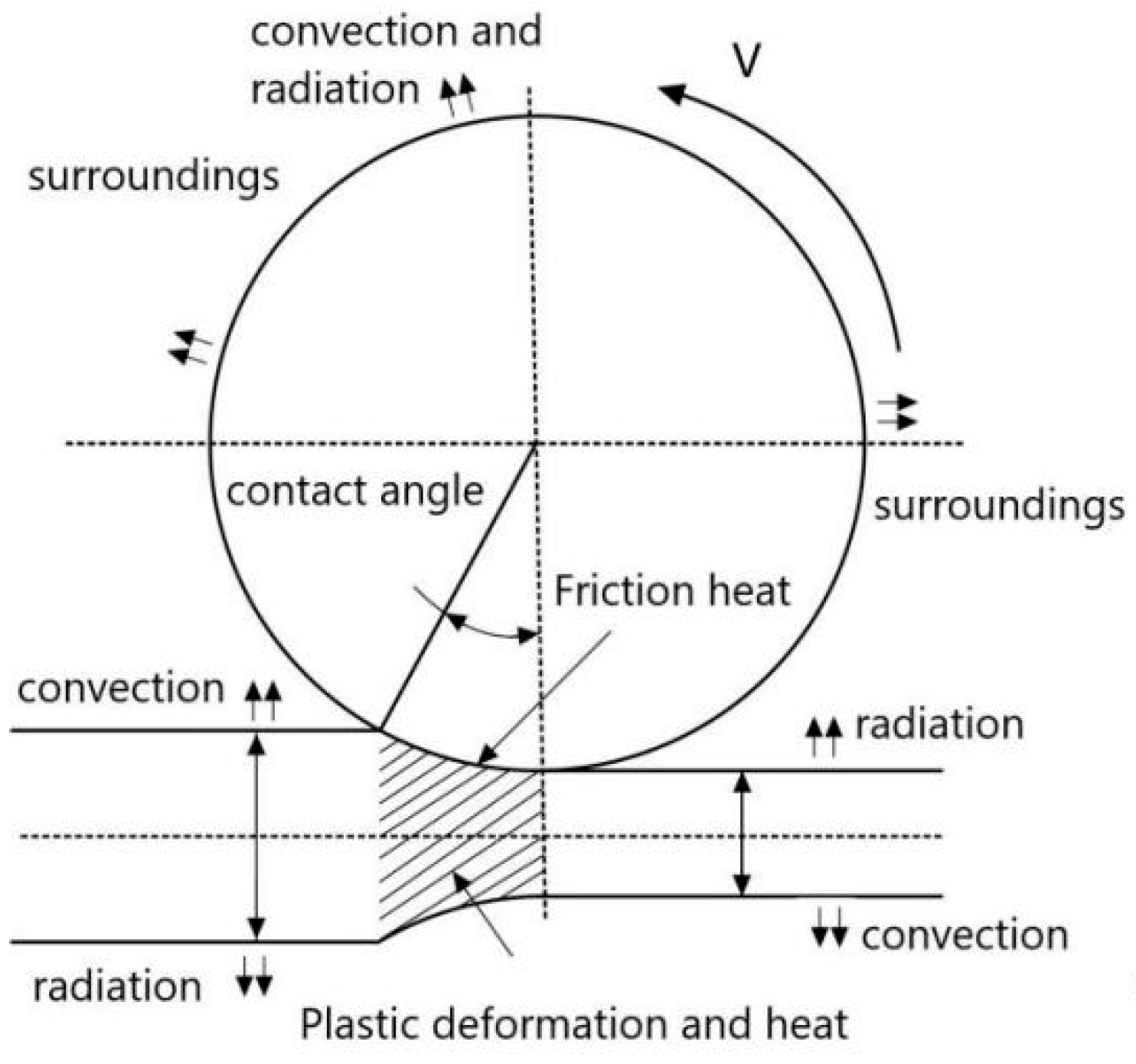
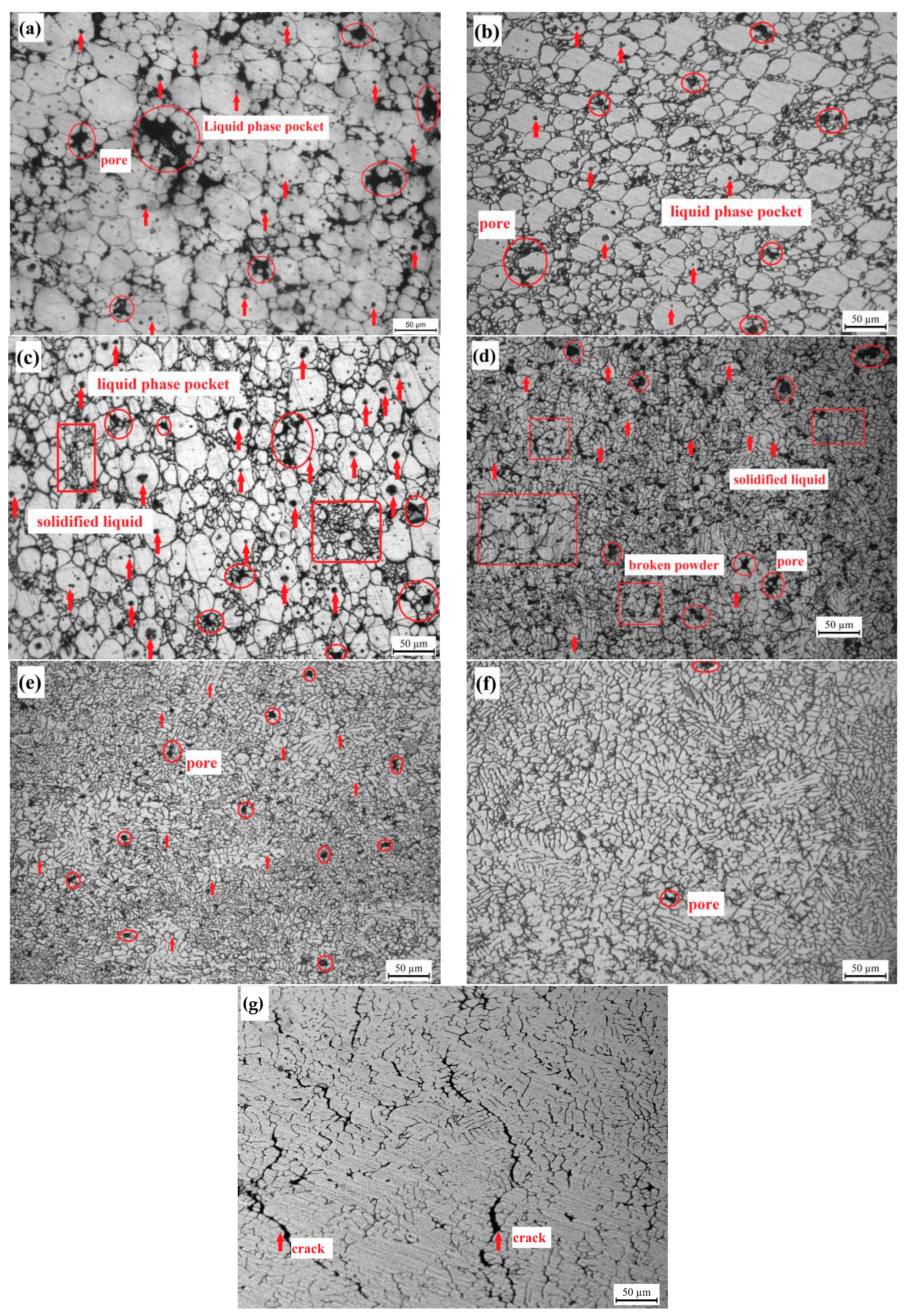


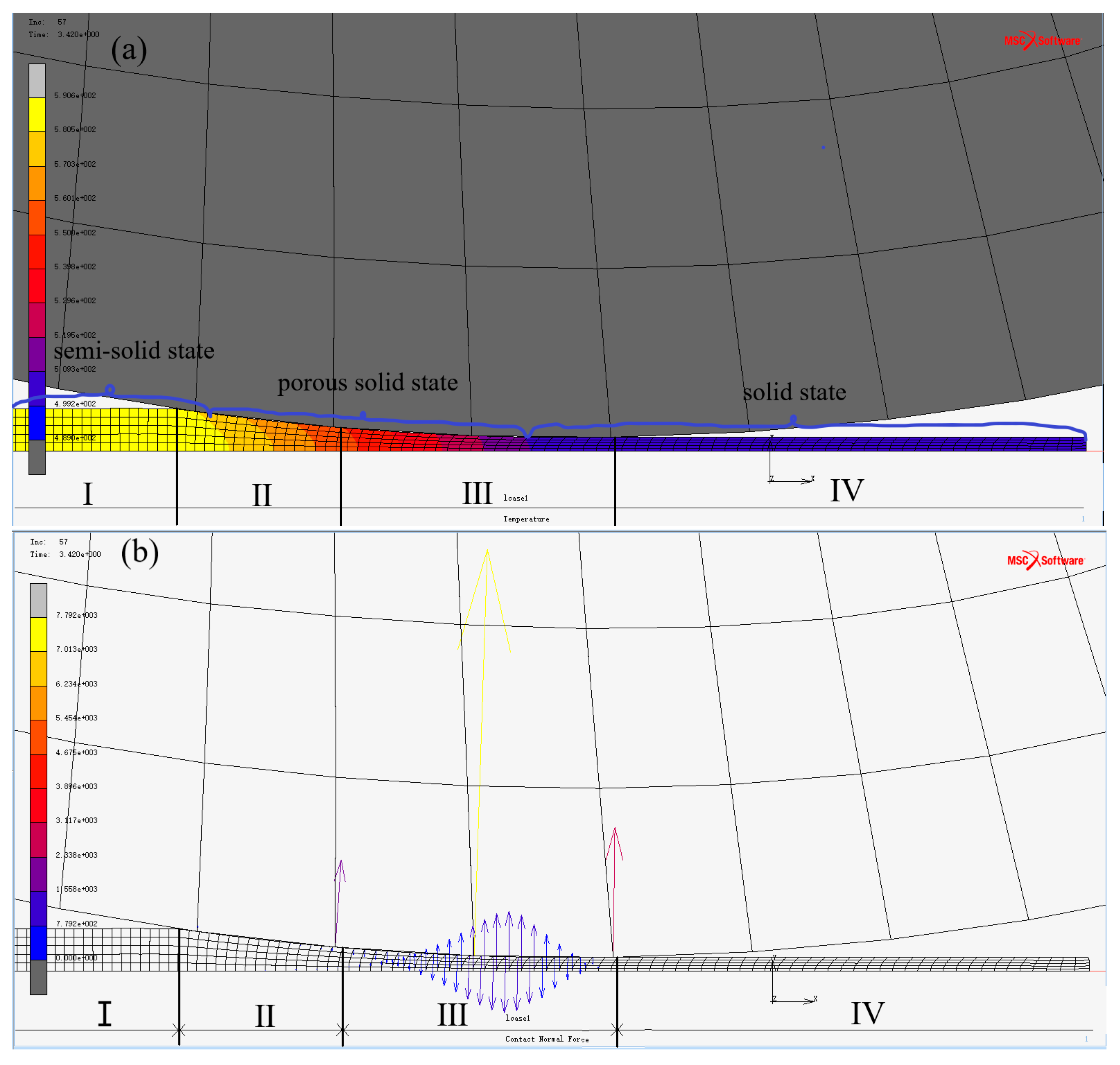
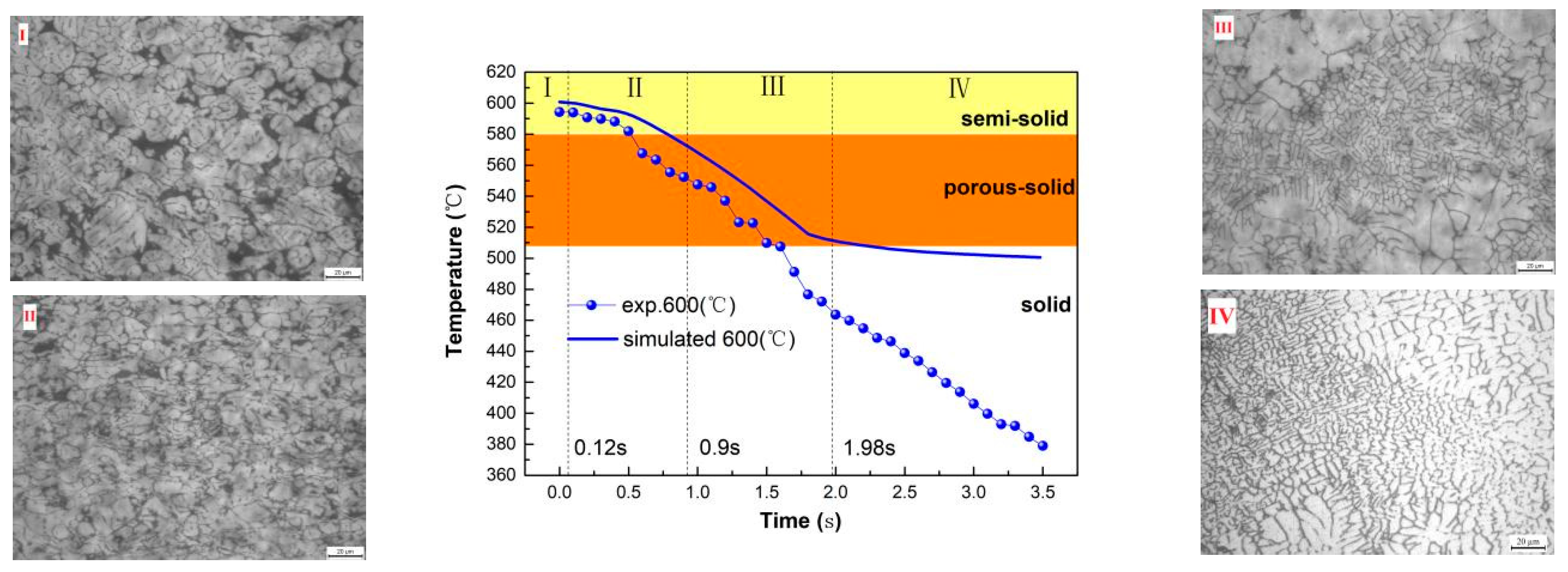
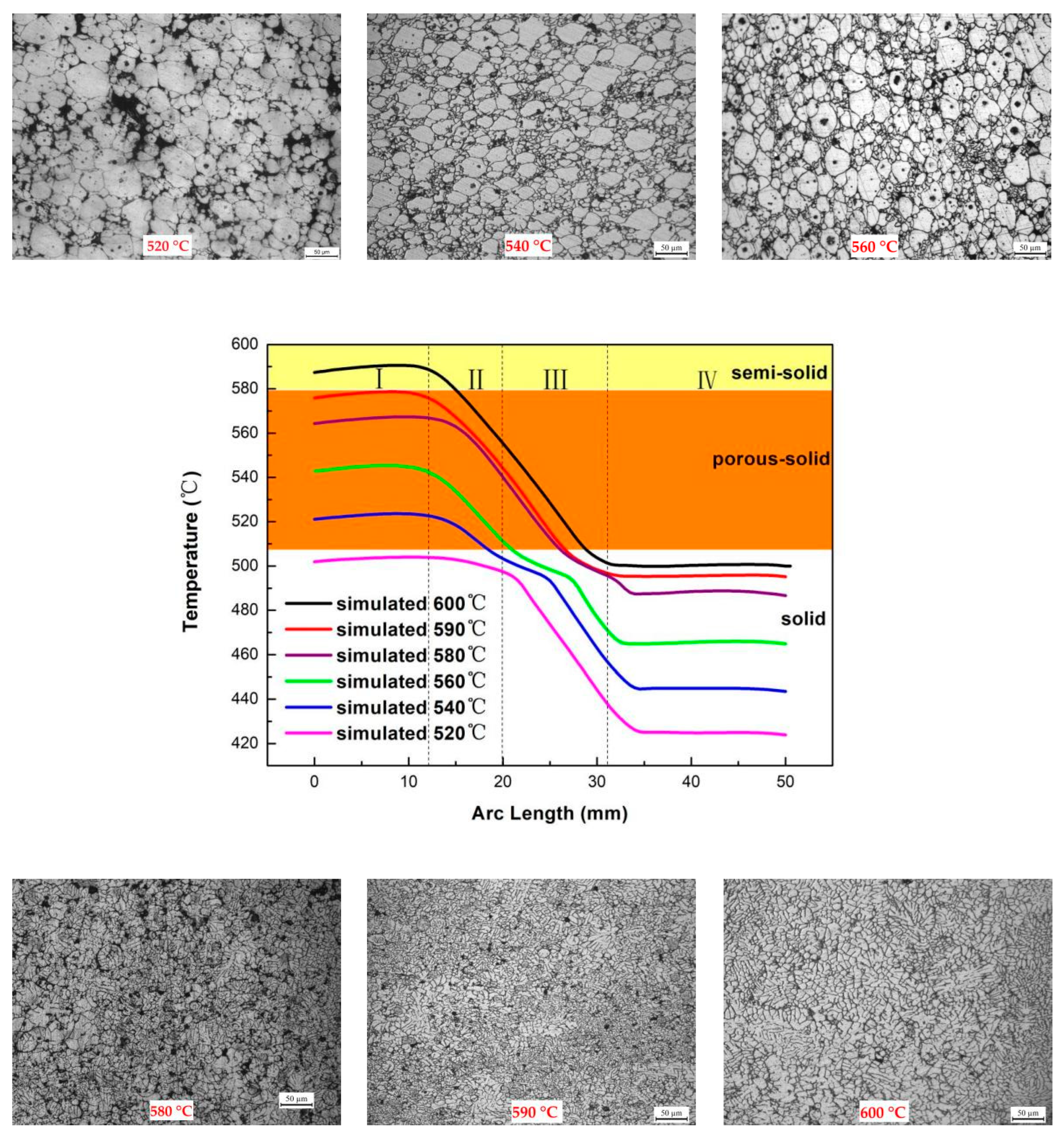
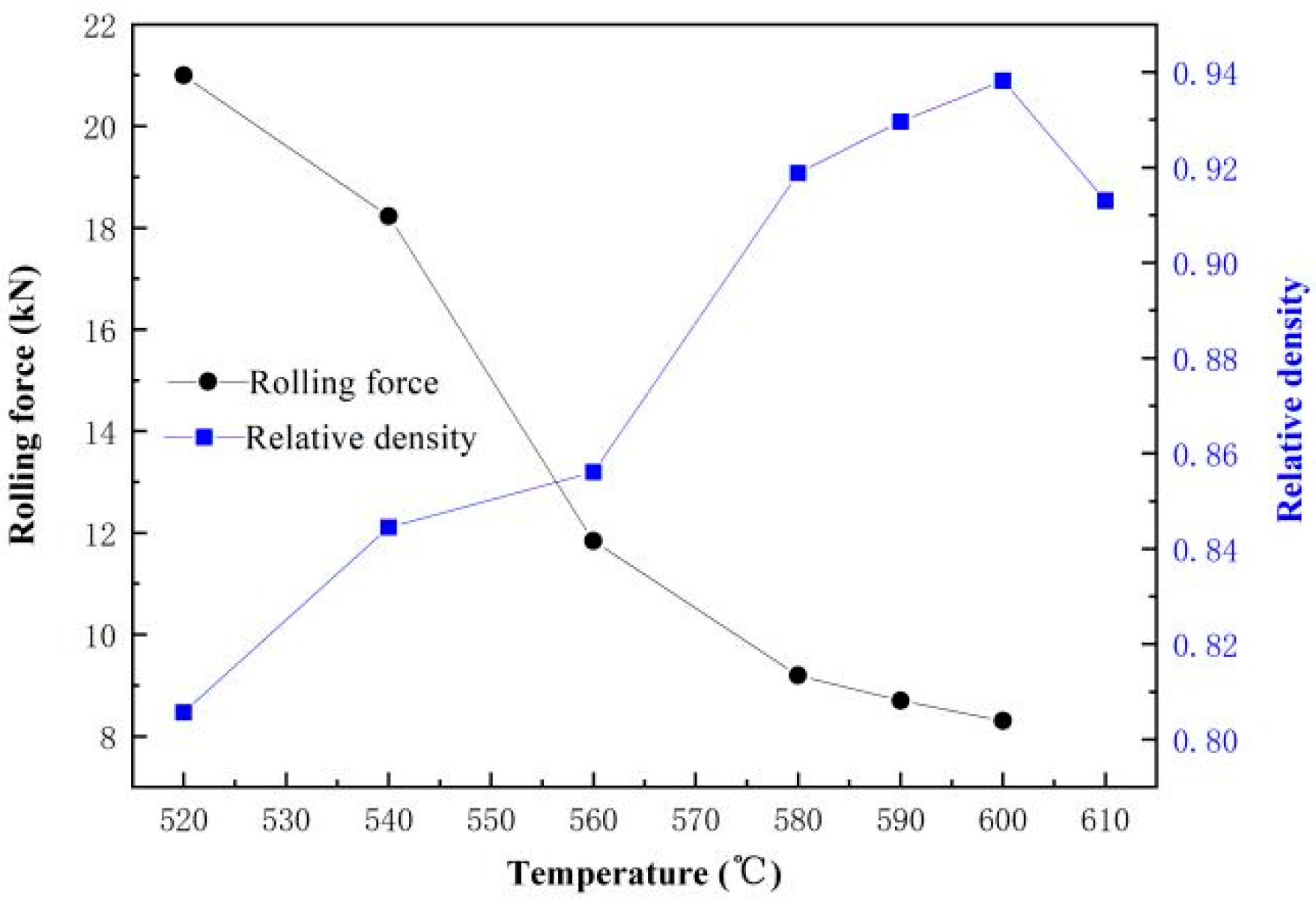
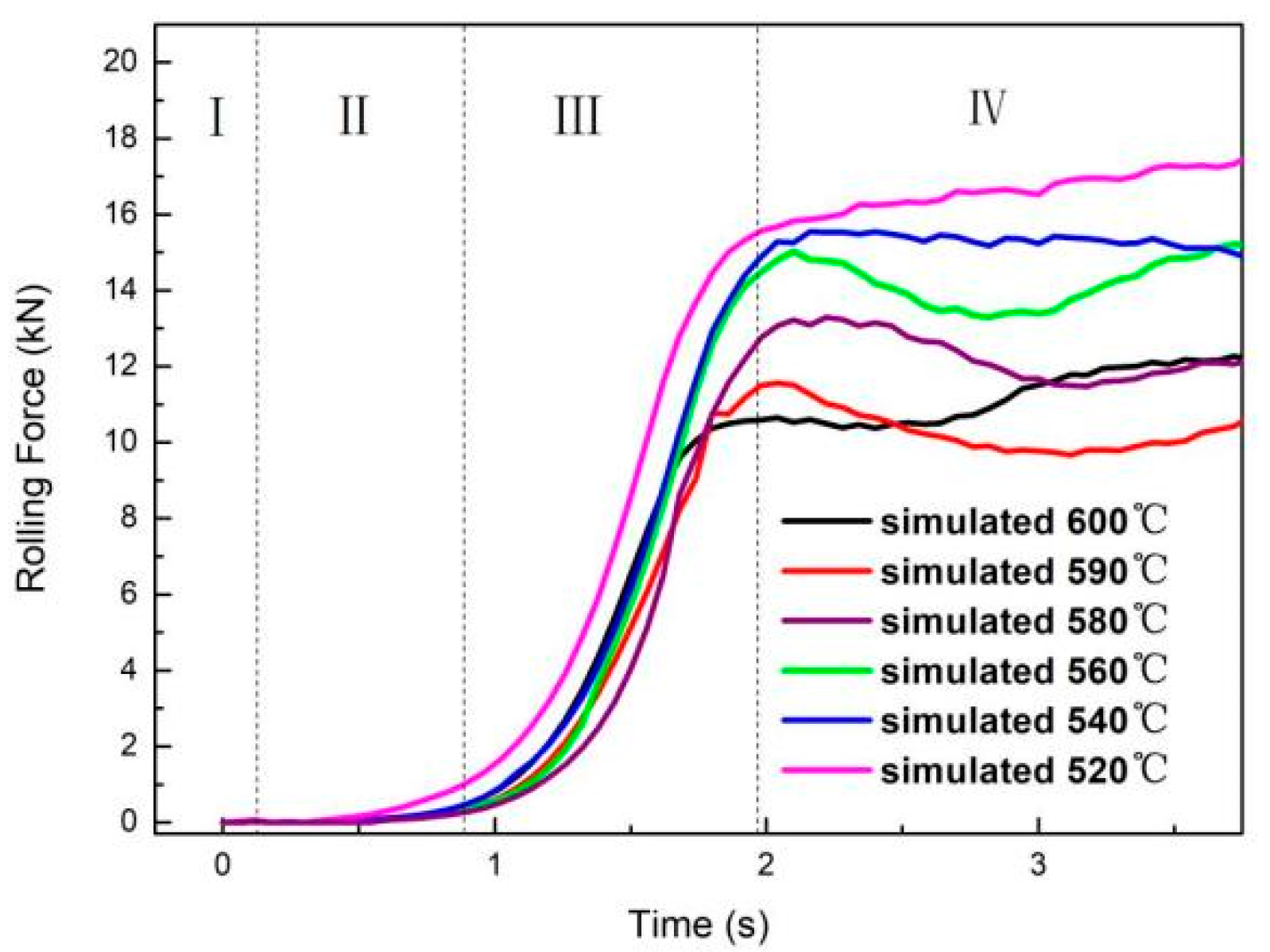
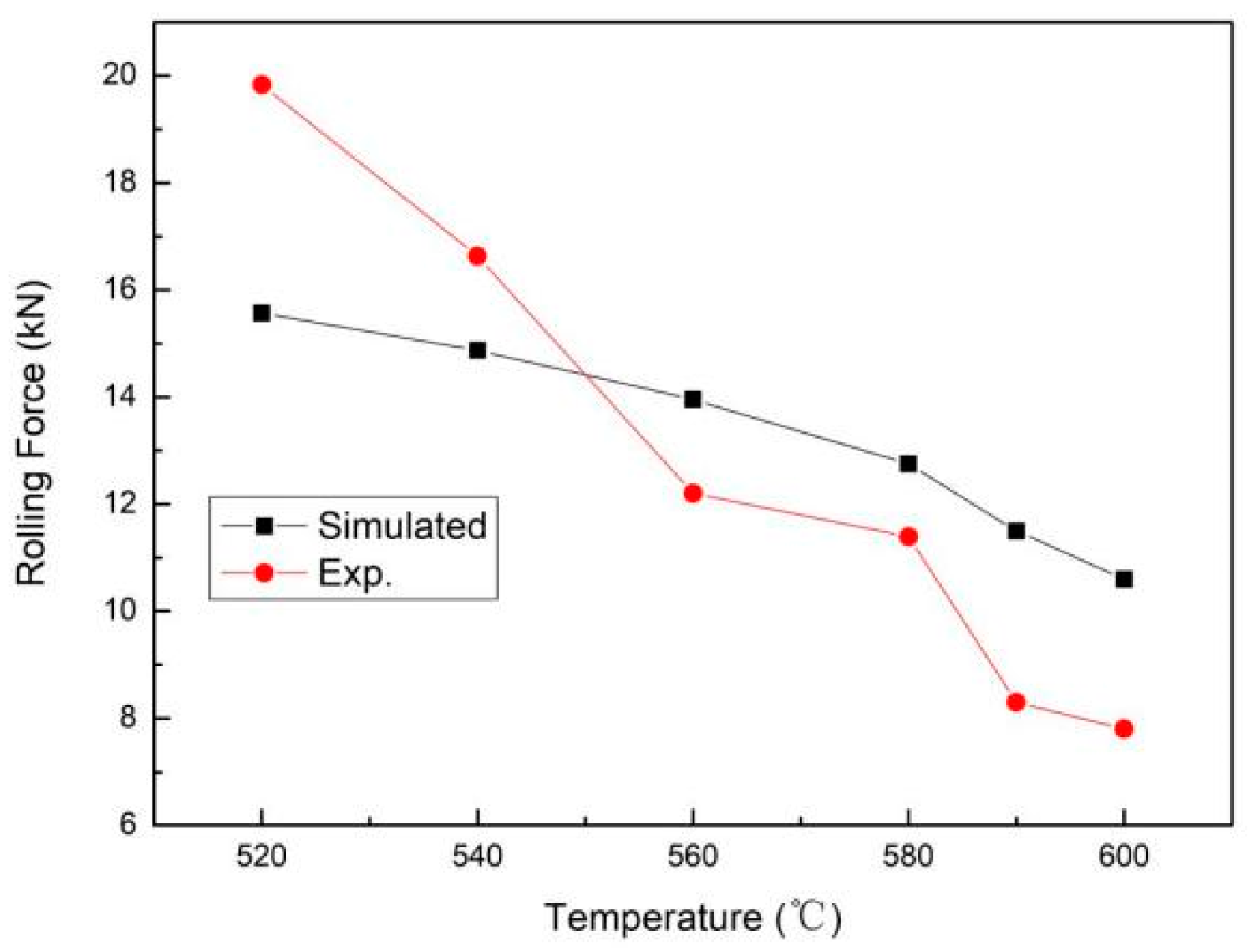

| Cu | Mg | Mn | Fe | Si | Zn | Ti | Cr | Al |
|---|---|---|---|---|---|---|---|---|
| 4.09 | 1.8 | 0.54 | 0.21 | 0.12 | 0.06 | 0.02 | 0.10 | Bal |
| Rolling Parameter (86CrMoV7) | Material Parameters (2024 Al) | ||
|---|---|---|---|
| Supply thickness (mm) | 5 | Powder temperature (°C) | 600 |
| Roller size (mm) | Φ150 × 100 | ||
| Deformation thickness (mm) | 3.75 | Density (g/cm3) | 2.77746 |
| Rolling speed (rad/s) | 0.1 | Initial relative density | 0.4 |
| Roller temperature (°C) | 300 | Heat dissipation coefficient between rollers and the billet (W/m2 K) | 2700 |
| Friction factor | 0.26 [10] | ||
Disclaimer/Publisher’s Note: The statements, opinions and data contained in all publications are solely those of the individual author(s) and contributor(s) and not of MDPI and/or the editor(s). MDPI and/or the editor(s) disclaim responsibility for any injury to people or property resulting from any ideas, methods, instructions or products referred to in the content. |
© 2023 by the authors. Licensee MDPI, Basel, Switzerland. This article is an open access article distributed under the terms and conditions of the Creative Commons Attribution (CC BY) license (https://creativecommons.org/licenses/by/4.0/).
Share and Cite
Wu, M.; Cai, R.; Wang, Y.; Luo, X.; Yu, J.; Zeng, X. The Effect of Powder Temperature on Semi-Solid Powder Rolling AA2024 Based on Experiments and Numerical Simulation. Metals 2023, 13, 1919. https://doi.org/10.3390/met13121919
Wu M, Cai R, Wang Y, Luo X, Yu J, Zeng X. The Effect of Powder Temperature on Semi-Solid Powder Rolling AA2024 Based on Experiments and Numerical Simulation. Metals. 2023; 13(12):1919. https://doi.org/10.3390/met13121919
Chicago/Turabian StyleWu, Min, Renye Cai, Yankun Wang, Xia Luo, Junjie Yu, and Xiangkun Zeng. 2023. "The Effect of Powder Temperature on Semi-Solid Powder Rolling AA2024 Based on Experiments and Numerical Simulation" Metals 13, no. 12: 1919. https://doi.org/10.3390/met13121919





